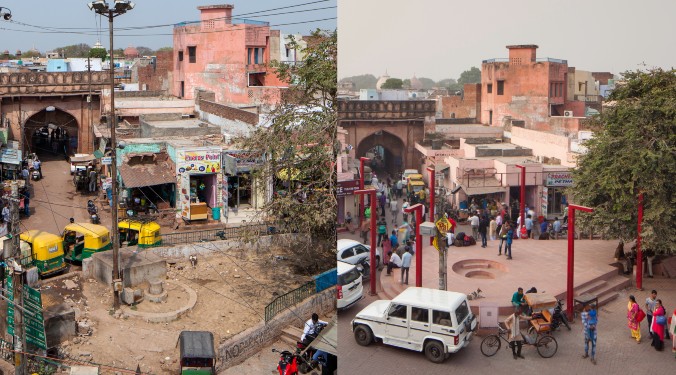Climate Sensitive Urban Design (CSUD) for Climate Change Mitigation in Heritage Cities: A tale of the Tajganj Urban Redevelopment, Agra

While the world is evolving with comprehensive plans in place to mitigate the climate change impact and revitalize the city centers, the emergent solutions are highly siloed and stereotyped.
Cities have been vital hubs for cultural, social, and economic activities since time immemorial. With the advent of rapid urbanization, a record- breaking population now lives in cities, crippling the burgeoning urban centers. Coupled with climate change, the urban climate faces an unprecedented challenge to tackle the global rise in temperature and the risk of urban disaster- flash floods and urban droughts- alike. However, when it comes to unpacking the urban climate risk-resilience continuum, one thing is evident- the cities in the global south are at a higher risk of damage. For instance, flash floods in London and in Agra will have a varying impact in terms of the loss they incur underpinned by the dichotomy of the developed and the developing.
However, Studio Archohm has devised a sustainable approach in confluence with the emerging concept of Climate Sensitive Urban Design (CSUD). In doing so, Archohm has been emphasizing building climate-resilient urban centers wherein architects, designers, planners, and city administrators coalesce to collaborate. The Taj Ganj Urban Redevelopment is one such classic example of revitalizing an old city center by adopting CSUD approaches viz land use planning, urban greening, urban geometry design, and vernacular architecture to combat urban heat. The vision, from the onset, has been to set a benchmark and create a model of interventions, a prototype contrary to the stereotype that can be adapted to any of the many heritage cities in India.
The tale of Tajganj, Agra, emerges from the qualitative relationship between built volume and built density- the open spaces and their spatial configuration- the urban layout. The vernacular materials, minimalist ideology, and green spaces are imbibed together as major modifiers for the urban microclimate. The project thus navigates through the need to connect the built environment, natural flows, and sys, and living traditions to take responsibility to heal and rejuvenate the urban historic fabric of Agra- the former imperial capital of India. While the idea has been to make visitors keep coming to Agra, to prolong their stay and thus revive the urban economy, the intent has been to create a symbiotic conversation.
Thus, the old city eventually reads as a coherent sustainable narrative mindful of its microclimate. In concurrence, the interests of all stakeholders have been considered- tourists (both national and international), local denizens (who seemed to have gotten lost in translation), policymakers, people, artists, and historians alike. Taj Ganj- a four centuries old district right outside the Taj Mahal, with its complex land use underpinned by erstwhile markets appropriated into residential neighborhoods called Bastis or Katras, sporting a few heritage monuments, Havelis, and mostly slums were already at a high risk of any unforeseen urban hazard. Due to its high population density, patterns of urban decay and crumbling infrastructure, and its of open
spaces, Taj Ganj had undoubtedly become an urban heat island in the dire need of retrofitting, rejuvenation, and thus redevelopment. From large-scale interventions to the basic level of street signages, from planning to the last detail of street pavements, the emphasis has been on vernacular materials- red sandstone, cobblestone, perforated jail, and urban greening while simultaneously preserving the existing green spaces. The overall intent has been to create a climate-responsive and resilient TajGanj in Agra.
Studio Archohm’s approach to urban redevelopment in old city areas in India is based on the mandate that celebrating one’s heritage means recognizing the very necessity of relating to the narratives of the past. However, it does so in a way that is scalable to contemporary societal, cultural economic, and most significantly the environmental needs of people, places, and paradigms. Not to mention its envisioning to empower the future possibilities. It posits that the ‘preserved’ past never remains static but is dynamic. “So in reality, what is, is not, what once was.” Change refers to ‘value addition’ by subsequent generations and it celebrates the design that is climate sensitive. responsive, and resilient.
For more information:- http://www.archohm.com/
Cookie Consent
We use cookies to personalize your experience. By continuing to visit this website you agree to our Terms & Conditions, Privacy Policy and Cookie Policy.





